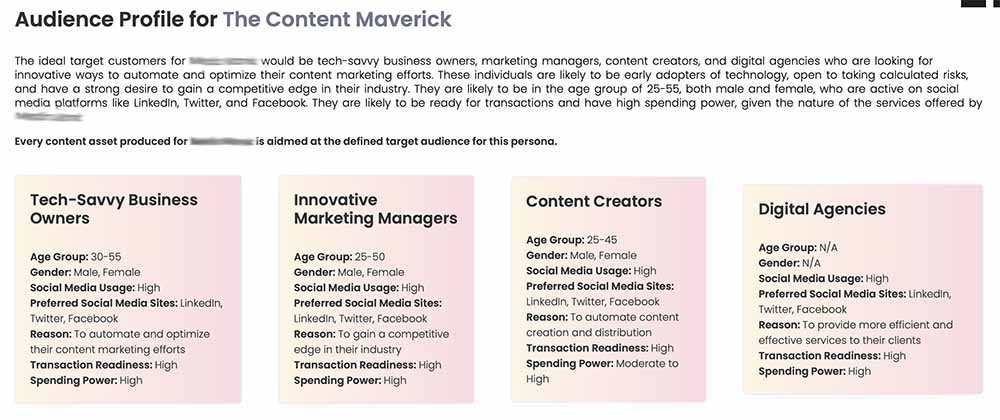
Table of Contents
Using Brand Voice & Audience Insights For Facebook Target Audience List
As marketers, we understand the importance of speaking to the right people at the right time. But what happens when your brand voice and tone are lost in translation? When it comes to Facebook marketing, having a clear brand voice and targeting the right audience is crucial to maximizing the impact of your ads. At Media Monk, we believe that understanding your target audience is just the beginning for creating a Facebook target audience list. Our AI-powered platform takes it a step further by helping you build a brand voice and tone that resonates with your audience.
Our innovative audience targeting feature uses machine learning algorithms to identify and categorize your ideal audience based on demographics, behaviors, and interests. But that’s not all – our platform also helps you develop a brand voice and tone that speaks directly to your target audience. By leveraging natural language processing and machine learning, our AI-powered engine analyzes your brand’s unique tone and language patterns, ensuring that your messaging is consistent across all channels.
The result is a seamless brand experience that resonates with your target audience, increasing engagement and driving conversions. With Media Monk, you can say goodbye to generic, one-size-fits-all marketing and hello to personalized, data-driven campaigns that speak directly to your audience. By combining the power of AI-powered audience targeting with our advanced brand voice and tone building features, you can create a marketing strategy that truly stands out in a crowded digital landscape.
By leveraging the full potential of our AI-powered platform, you can unlock new levels of marketing efficiency and effectiveness. Whether you’re a solopreneur, small business, or marketing consultant, our innovative solutions empower you to stay ahead of the curve and achieve your goals with ease. So why settle for mediocre marketing results when you can revolutionize your content marketing strategy with Media Monk?
Understanding Audience Categorization
One way to categorize your audience is by demographics, which includes factors such as age, gender, location, and language. For instance, if you’re promoting a product that’s popular among young adults, you can create a category for 18- to 34-year-olds who live in urban areas. This allows you to tailor your messaging to resonate with this specific age group and geographic location.
Another approach is to categorize your audience based on their interests and behaviors. For example, if you’re promoting a fitness program, you can create categories for people who have shown an interest in fitness, wellness, or sports. You can also categorize based on behaviors such as purchase history or engagement with similar content.
Effective audience categorization also involves understanding the nuances within each category. For instance, within the 18- to 34-year-old demographic, you may have sub-categories for college students, young professionals, and parents. By recognizing these sub-categories, you can create highly targeted messaging that speaks directly to their needs and concerns, increasing the likelihood of engagement and conversion.
Optimizing Your Audience List
One effective way to refine your target audience is by using Facebook’s built-in features, such as the ‘Audience Insights’ tool. This tool provides valuable information about your target audience, including demographics, interests, and behaviors. By leveraging this data, you can create more targeted ads that resonate with your audience, increasing the likelihood of conversions and engagement.
To further optimize your audience list, consider using custom audiences and lookalike audiences. Custom audiences allow you to target users who have already interacted with your brand, such as website visitors or customers. Lookalike audiences, on the other hand, enable you to target users who share similar characteristics with your existing customers. By combining these strategies, you can create a highly targeted and effective audience list.
Another crucial aspect of optimizing your audience list is regularly monitoring and updating your targeting criteria. As your business and marketing strategy evolve, your target audience may shift, and your Facebook ads should adapt accordingly. By regularly reviewing your performance data and adjusting your targeting criteria, you can ensure that your ads remain relevant and effective, maximizing your return on investment.
Selecting the Right Target Audience

To identify the right target audience, start by analyzing your customer data, website analytics, and social media insights. This will help you understand demographics, interests, and behaviors that align with your brand. For instance, if you’re a fashion brand, you may find that your target audience is predominantly female, aged between 25-45, and interested in fashion and lifestyle.
One effective way to segment your target audience is by creating buyer personas. These are semi-fictional representations of your ideal customer, including their goals, challenges, and motivations. By creating multiple buyer personas, you can tailor your ad messaging and creative assets to resonate with each group. For example, a fitness brand may have personas for ‘busy professionals’ and ‘fitness enthusiasts’, each with distinct pain points and preferences.
Another key consideration when selecting the right target audience is to identify lookalike audiences. This involves targeting users who resemble your existing customers or followers. By using Facebook’s lookalike audience feature, you can expand your reach to new users who are likely to be interested in your brand. This can be particularly effective for brands with a strong existing customer base, as it allows you to tap into untapped markets and increase brand awareness.
Enhancing Facebook Ad Groups
By categorizing your audience into distinct groups, you can tailor your ad creative, messaging, and bidding strategies to resonate with each segment. This level of personalization enables you to speak directly to the needs and pain points of each group, increasing the likelihood of conversion and driving more meaningful engagement.
One effective way to organize your ad groups is by demographics, such as age, location, or interests. For example, a fashion brand may create separate ad groups targeting young adults, middle-aged professionals, and retirees, each with tailored messaging and creative assets. This approach ensures that the right message reaches the right audience, maximizing the impact of your ad spend.
Another key benefit of targeted ad groups is the ability to optimize and refine your campaigns over time. By monitoring the performance of each ad group, you can identify areas of improvement and make data-driven decisions to adjust your targeting, budget allocation, and ad creative. This continuous optimization process enables you to refine your targeting and improve the overall effectiveness of your Facebook ad campaigns.
Maximizing Audience List Optimization
One effective way to optimize your audience list is to leverage Facebook’s built-in features, such as custom audiences and lookalike audiences. By creating custom audiences based on your website traffic, customer lists, or engagement, you can target high-value users who have already shown interest in your brand. Additionally, lookalike audiences allow you to target users who resemble your existing customers, increasing the likelihood of conversion.
Another crucial aspect of audience list optimization is refining your targeting criteria. This involves regularly reviewing and updating your targeting options to ensure they align with your marketing goals. For instance, if you’re promoting a new product, you may want to target users who have shown interest in similar products or have purchased from your brand before. By continuously refining your targeting criteria, you can increase the relevance of your ads and improve their overall performance.
Staying up-to-date with market trends and adapting to changes in user behavior is also essential for maximizing the effectiveness of your audience list. This involves monitoring industry reports, analyzing your ad performance data, and adjusting your targeting strategy accordingly. For example, if you notice that a particular age group or interest is performing well, you can adjust your targeting criteria to focus more on those segments. By staying agile and adapting to changes in the market, you can ensure your Facebook ads remain effective and drive meaningful results for your business.
In Closing
By implementing these strategies for creating an effective Facebook target audience list, you can elevate your marketing efforts and achieve better results. Embracing AI-powered solutions like Media Monk can further enhance your ability to reach and engage with the right audience on Facebook.


